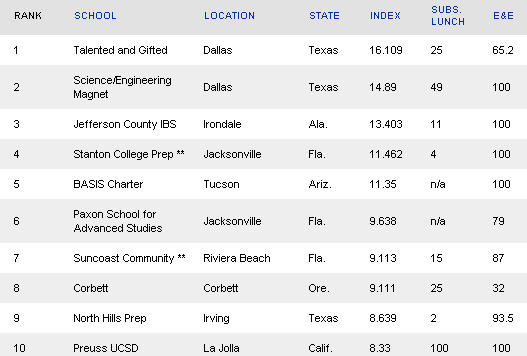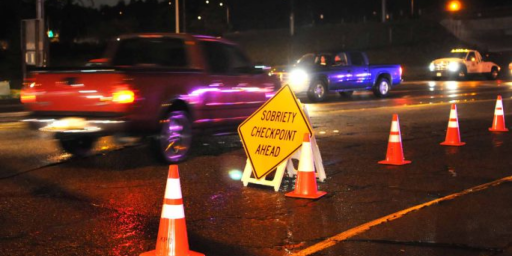Top U.S. High Schools
Newsweek ranks the Top 1500 U.S. high schools by a rather odd formula “the number of Advanced Placement, Intl. Baccalaureate and/or Cambridge tests taken by all students at a school in 2008 divided by the number of graduating seniors.” Aside from taking of tests — and not, say, scores on said tests — is the sole criteria strikes me as more than a tad strange. Betsy Newmark and Dan Brown agree, with the latter especially agitated on the matter. Jay Matthews, who devised the measure, defends it.
Another thing strikes me as odd from a quick look at the rankings:
It’s dominated by schools in Red states. Dallas holds down the top two spots, followed by a school in the Birmingham suburbs. Only two schools in traditional Blue states make the top 10 — at numbers 8 and 10.
Do Red states have more magnet schools, which siphon off the best students? Are they more likely to push taking these particular tests? Or is it just an anomaly of some sort?







The two matches stand out: Dallas at 1 and 2; Jacksonville at 4 and 6
I suspect the schools are competing with each other on what Dan Brown identifies as easily manipulatable ranking system.
When you use “Red State,” I am assuming you are referring to how the state voted in the national election.
So, I’m not sure how you define “dominated” since “red state” schools don’t even constitute a majority of the list.
Furthermore, to suggest that the state political behavior has any explanatory power over local school performance is silly. You might as well argue that students perform better in warmer weather since the list is dominated by schools in warmer climates.
If you took a more appropriate geography–say, the municipality–you would see that the list is actually dominated by schools in “Blue” cities and counties.
Obama won Dallas County with 57% of the vote; he beat McCain in Tucson by 52%; Palm Beach County, he won by 67%; San Diego County by 54%, etc….
Too bad the list didn’t include private schools.
Triumph, where do you think the parents of the students in these schools stand on school choice?
Looking at the methodology, it looks more like a measure of affluence.
Steve
Or is it just an anomaly of some sort?
It’s an anomaly. Don’t infer from this that Dallas has good schools. It doesn’t.
High scores are often a function of exclusion. Give me 100 kids — any 100 — but let me exclude 60 by my choice. I’ll show you great scores.
It’s one of the ways Europe and Asia always seem to outperform us. They often have a less small “d” democratic approach, less inclusive.
The G and T schools obviously outperform by excluding all average and below average students. Student bodies in very wealthy areas may outperform. Other anomalies apply. My kids used to attend a school where virtually the entire student body were children of Duke and UNC faculty.
The ratings are to be taken with a large pinch of salt.
Michael, you think the kids at the “Talented and Gifted” school are not a random selection? Isn’t a possible that the school at the bottom of the list, Sisters of Mercy Housing for Unwanted Boys might be at the top of the list with a more affirming name? Me neither.